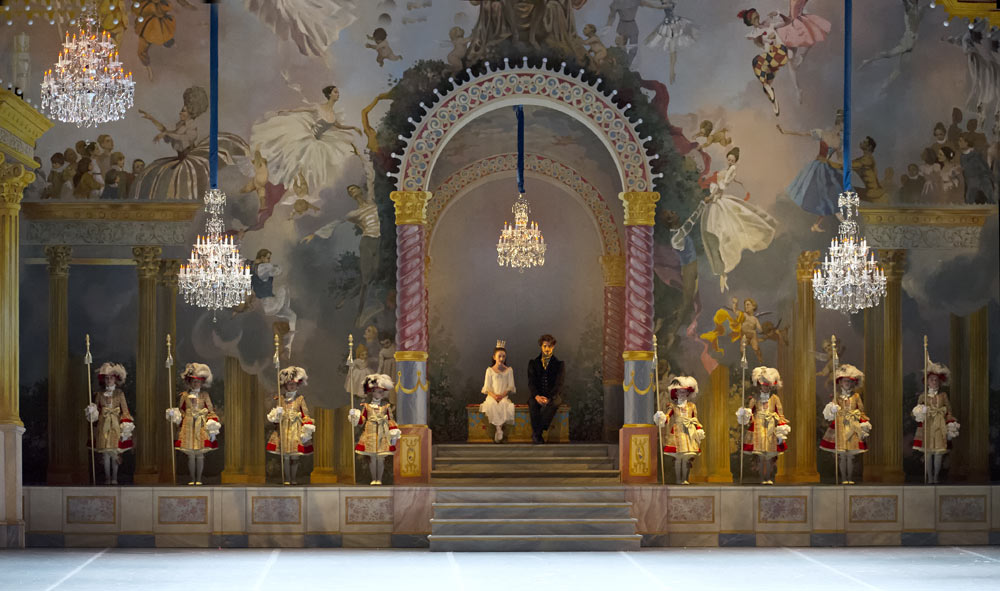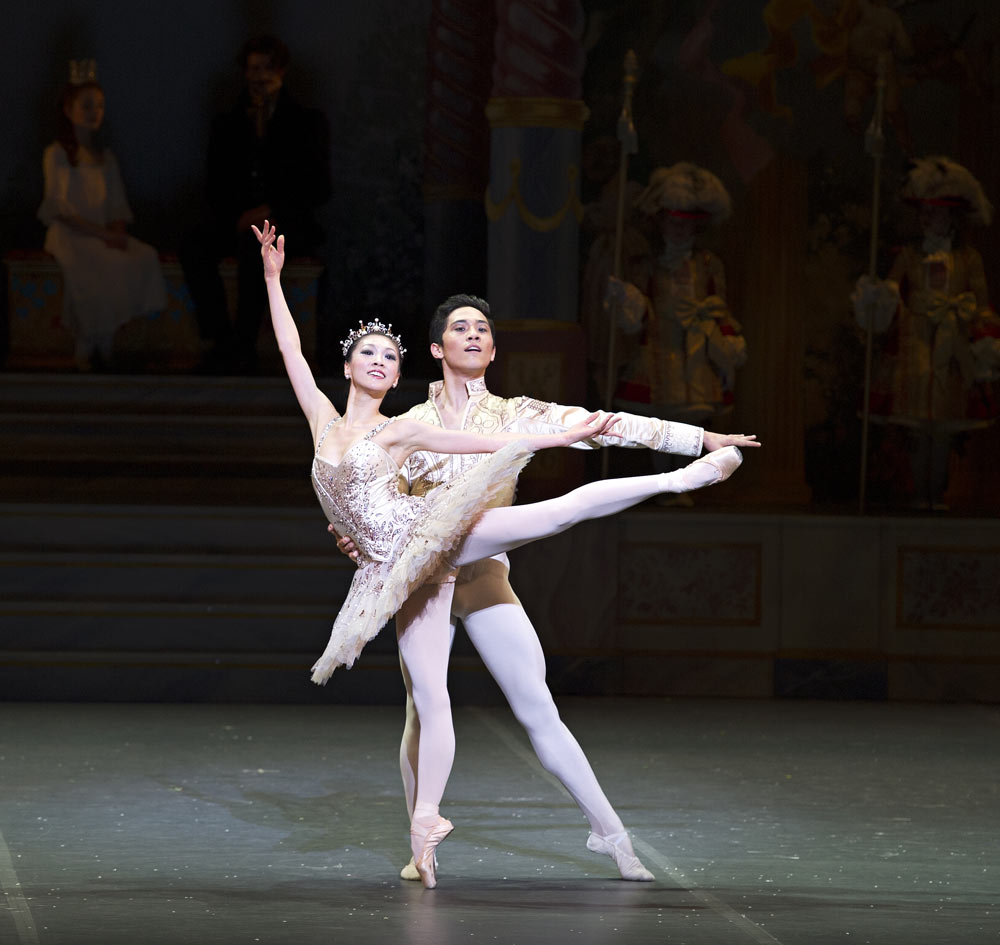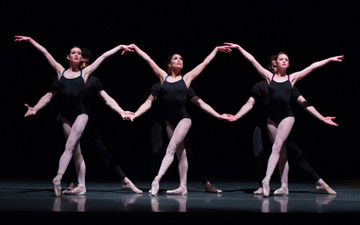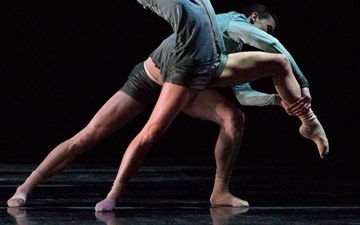
© Gene Schiavone. (Click image for larger version)
Boston Ballet
The Nutcracker
Boston, Opera House
Nov/Dec 2012
www.bostonballet.org
www.bostonoperahouse.com
Boston Ballet decided last year that instead of spending money to refurbish its Nutcracker, it would create a new production from scratch. The old production was justly celebrated since every holiday season more people saw it than saw any other Nutcracker in the world. Of course, you can sell lots of tickets when you perform in a 3600-seat barn of a venue, as the company did for decades at the Wang Theater. But in 2004 the company was evicted to make room for the likes of Riverdance and the Rockettes, and it now performs in its new home, the 2600-seat Boston Opera House. Locals were concerned about the demise of the former production, but they needn’t have worried: Boston Ballet’s new Nutcracker is a triumph.
For one thing, it’s drop-dead gorgeous, thanks to the unfailing taste and ingenuity of designer Robert Perdziola. The drop curtain now shows an enormous Victorian Christmas card depicting yet another stage, this one featuring its own curtain showing the cloud-borne castellated Land of the Nutcracker Prince. When the curtain rises, that Christmas card stage remains, then soon thereafter ITS curtain rises, revealing Drosselmeier’s workshop. Now, instead of completing the nutcracker in ominous solitude, he performs for a band of happy street urchins. It’s immediately clear that this will be a sunnier Nutcracker than of yore. In the ball scene, the Biedermeier dresses of old are now high-waisted Regency gowns (think Jane Austen) in pastel mauves and blush pinks while the men and boys wear handsome beige and aubergine tailcoats and white trousers.

© Rosalie O’Connor. (Click image for larger version)
The sets are also a big improvement. The ballroom, formerly a harsh turquoise, shines with warm browns and burnished golds. The conifer domain of the Snow King and Snow Queen is now a birch forest (very Russian, that), and the backdrop for the second act divertissements is a happy blend of Fragonard and Maxfield Parish. In that same second act, two glittering chandeliers hang outside the proscenium and into the audience, adding to the five on stage. The effect is increased far more than the mathematical two-fifths, and the results are magnificent. Perdziola uses the same kind of visual legerdemain for his Christmas tree. The Opera House stage is just over 42’ high, but instead of showing us a 42’ Christmas tree, he shows only the bottom half of the tree. The tree now soars far out of sight, creating the impression of something truly gigantic.
Better yet, the production is guided throughout by unerring intelligence. Four examples show what I mean. Just before the overture begins, Clara wanders on stage alone, bemused and looking idly about her. When she arrives at stage center, she looks out, sees an audience of thousands of spectators, and beams with delight. As the guests leave the party, a father carries his sleeping daughter off stage. Once Drosselmeier gives his watch to Fritz, Fritz and Clara are mesmerized all the way off stage, just as children naturally would be. Last to leave the ballroom, the maid checks the fire before exiting. Such savvy touches of verisimilitude vivify the production, making this the smartest Nutcracker I’ve ever seen.

© Gene Schiavone. (Click image for larger version)
As for the dancing, the major roles were performed brilliantly all three times I saw the ballet. The first two occasions I was lucky to see Jeffrey Cirio as the Nutcracker and Misa Kuranaga as the Sugar Plum Fairy. I’ve written recently about Cirio’s meteoric rise through the ranks from corps to principal, and it’s immensely satisfying to see him go from triumph to triumph. Attractive, charming, and technically superb with great balance and impressive leaps, he performs with a youthful delight that’s infectious. Kuranaga is also a wonder to behold: a whisper of a young woman who combines great charm and authority and who handles the most difficult passages with grace and ease, making it all seem effortless, which of course is the most difficult illusion of all. Her pirouettes and double turns in her final variation were flawless. And together, Kuranaga and Cirio make a superb couple, performing with such sensitive musicality and balanced unison that it sometimes seems you’re watching a single composite creature.

© Gene Schiavone. (Click image for larger version)
Opening night, the dependably excellent Lia Cirio performed Dew Drop and the Snow Queen and King were danced by Kathleen Breen Combes and Paolo Arrais, the latter recently promoted to principal. As for Breen Combes, I’ve rarely seen a more glorious dancer. This time I was struck by how the way she uses her hands and arms can make you swoon. Beautiful, charismatic, confident, she conveys intimations of otherworldliness. I find her so mesmerizing that I lose all sense of time and place, often forgetting to take notes. Arrais was a capable partner, attentive and cavalier and modestly retiring. At my second performance, Breen Combes danced Dew Drop with her usual brilliance. Imagine: Cirio, Kuranaga, and Breen Combes in the same performance! I thought I’d died and gone to heaven.
At my third performance, Whitney Jensen and Lasha Khozashvili were Nutcracker and Sugar Plum Fairy. Although each performed extremely well, they conveyed little rapport. Ashley Ellis and Paulo Arrais were a commendable Snow Queen and King, and Diana Albrecht from the corps danced a Dew Drop that gave intimations of future distinction. Opening night’s Chelsea Perry was the best of my three Claras, and Sabi Varga was my favorite Drosselmeyer, the uncle you wish you’d had. The estimable Jonathan McPhee conducted the orchestra with his usual brio.

© Gene Schiavone. (Click image for larger version)
There’s rarely so much honey without flies, so Perdziola should attend to the women’s tops in the Waltz of the Flowers: they look like ribbed cotton tank tops, something you’d see in a gym but not a ballet. I was also sorry that Artistic Director Mikko Nissinen, who has guided this new production and who claims credit for 30% of the choreography, uses only three men in the Russian dance. In the old days, five men made for a much more powerful dance—another case in which an additional fraction more than doubles the effect. The lighting is sometimes too dim, and in the second act Clara and Drosselmeyer sit in an alcove so deeply recessed it’s hard to believe they can see the divertissements.
The final scene echoes the opening when Clara first discovers the audience. Now asleep on a couch in the dark ballroom, she is visited in quick succession by dancers who performed for her in the second act. Upon awakening, she’s disappointed that her adventures have been a mere dream, but then realizes she’s still wearing the crown given her by the Sugar Plum Fairy. A happy surprise: her dream lives on as the curtain descends. She’s delighted, the audience is delighted, and I have no doubt that if they’d been able to attend, Petipa and Tchaikovsky would have been delighted too.

















You must be logged in to post a comment.